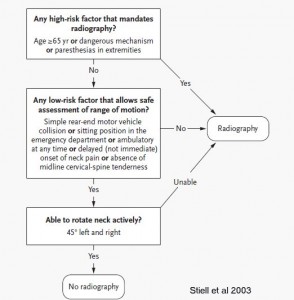 There is uncertainty about the optimal approach to screen for clinically important cervical spine (C-spine) injury following blunt trauma. A recent systematic review has investigated the diagnostic accuracy of the Canadian C-spine rule and the National Emergency X-Radiography Utilization Study (NEXUS) criteria to assist emergency physicians to assess the need for cervical spine imaging. The study included articles that reported on a cohort of patients who experienced blunt trauma and for whom clinically important cervical spine injury detectable by diagnostic imaging was the differential diagnosis; evaluated the diagnostic accuracy of the Canadian C-spine rule or NEXUS or both; and used an adequate reference standard. Methodologic quality was assessed using the Quality Assessment of Diagnostic Accuracy Studies criteria. For the Canadian C-spine rule, sensitivity ranged from 0.90 to 1.00 and specificity ranged from 0.01 to 0.77. For NEXUS, sensitivity ranged from 0.83 to 1.00 and specificity ranged from 0.02 to 0.46. One study directly compared the accuracy of these 2 rules using the same cohort and found that the Canadian C-spine rule had better accuracy. For both rules, a negative test was more informative for reducing the probability of a clinically important cervical spine injury.
There is uncertainty about the optimal approach to screen for clinically important cervical spine (C-spine) injury following blunt trauma. A recent systematic review has investigated the diagnostic accuracy of the Canadian C-spine rule and the National Emergency X-Radiography Utilization Study (NEXUS) criteria to assist emergency physicians to assess the need for cervical spine imaging. The study included articles that reported on a cohort of patients who experienced blunt trauma and for whom clinically important cervical spine injury detectable by diagnostic imaging was the differential diagnosis; evaluated the diagnostic accuracy of the Canadian C-spine rule or NEXUS or both; and used an adequate reference standard. Methodologic quality was assessed using the Quality Assessment of Diagnostic Accuracy Studies criteria. For the Canadian C-spine rule, sensitivity ranged from 0.90 to 1.00 and specificity ranged from 0.01 to 0.77. For NEXUS, sensitivity ranged from 0.83 to 1.00 and specificity ranged from 0.02 to 0.46. One study directly compared the accuracy of these 2 rules using the same cohort and found that the Canadian C-spine rule had better accuracy. For both rules, a negative test was more informative for reducing the probability of a clinically important cervical spine injury.
This study concludes that the Canadian C-spine rule appears to have better diagnostic accuracy than the NEXUS criteria.
Read more about canadian c-spine rules in Physiopedia here